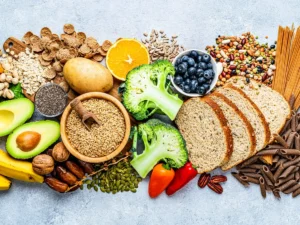Table of Contents
What is a Low-Fiber Diet?
While fiber is essential for overall health, a low-fiber diet can provide relief by minimizing the workload on the digestive system, reducing symptoms like bloating, gas, and diarrhea, and promoting healing after surgeries or during treatments.

Low-Fiber Diet: A Comprehensive Guide for Digestive Health
Who Needs a Low-Fiber Diet?
A low-fiber diet is typically recommended for:
- Inflammatory Bowel Disease (IBD): Including Crohn’s disease and ulcerative colitis, particularly during flare-ups.
- Diverticulitis: To reduce inflammation and prevent complications.
- Pre- and Post-Surgery: Especially before colonoscopies or after intestinal surgeries to allow healing.
- Radiation Therapy: For patients undergoing treatment that affects the gastrointestinal tract.
This diet is usually short-term and should be followed under medical supervision to ensure nutritional needs are met.
Pros and Cons of a Low-Fiber Diet
Pros
- Reduces Digestive Stress: Helps alleviate symptoms like bloating, gas, and diarrhea.
- Promotes Healing: Allows the digestive tract to rest and recover after surgeries or during flare-ups.
- Prepares for Medical Procedures: Ensures the digestive system is clear for colonoscopies or surgeries.
Cons
- Nutrient Deficiencies: Limiting fiber-rich foods can lead to inadequate intake of vitamins and minerals.
- Constipation: Reduced fiber intake may cause constipation in some individuals.
- Impact on Gut Health: Long-term adherence can negatively affect gut microbiota diversity.
While a low-fiber diet can be beneficial in the short term, it is not recommended for prolonged use due to its potential health risks.
How to Follow a Low-Fiber Diet
A low-fiber diet involves avoiding high-fiber foods like raw fruits, vegetables, whole grains, nuts, seeds, and legumes. Instead, focus on easily digestible foods such as refined grains, low-fiber fruits and vegetables, lean proteins, and healthy fats.
Foods to Avoid
- Whole grains (oats, quinoa, brown rice)
- Raw fruits and vegetables
- Nuts, seeds, and legumes
- Spicy and processed foods
Foods to Include
- Fruits: Bananas, melons, canned fruits, applesauce
- Vegetables: Cooked carrots, zucchini, spinach (without skins or seeds)
- Starches: White bread, white rice, plain pasta
- Proteins: Skinless poultry, fish, eggs, tofu
- Dairy: Milk, yogurt, mild cheeses (if tolerated)
Sample Low-Fiber Meal Plan
Day 1
- Breakfast: Scrambled eggs with white toast and applesauce
- Lunch: Grilled chicken breast with mashed potatoes and cooked carrots
- Dinner: Baked fish with white rice and steamed zucchini
- Snacks: Plain yogurt or ripe banana
Day 2
- Breakfast: Pancakes made with white flour and sliced bananas
- Lunch: Roasted turkey with steamed spinach and white bread
- Dinner: Tuna pasta with asparagus tips
- Snacks: Plain crackers with cheese slices
Day 3
- Breakfast: Cooked farina with creamy almond butter and an omelet
- Lunch: Baked lemon chicken with roasted beets and skinless sweet potato
- Dinner: Cooked acorn squash stuffed with ground turkey and tomato sauce
- Snacks: Cottage cheese with melon chunks
Tips for Following a Low-Fiber Diet
- Stay Hydrated: Drink plenty of fluids to prevent constipation.
- Eat Small, Frequent Meals: This can ease digestion and reduce discomfort.
- Chew Thoroughly: Proper chewing aids in the digestive process.
- Monitor Symptoms: Keep track of foods that cause discomfort and adjust accordingly.
- Cook at Home: Preparing meals from scratch allows better control over ingredients.
Risks and Side Effects
While a low-fiber diet can be beneficial in the short term, long-term adherence may lead to:
- Nutrient Deficiencies: Due to the exclusion of fiber-rich, nutrient-dense foods.
- Constipation: Reduced fiber intake can slow bowel movements.
- Altered Gut Microbiota: A lack of fiber can negatively impact gut bacteria diversity.
It is essential to reintroduce fiber gradually once symptoms subside, under the guidance of a healthcare professional.
How to Reintroduce Fiber Safely
When transitioning back to a regular diet, follow these steps:
- Start Slowly: Begin with small amounts of soluble fiber, such as oats or peeled apples.
- Monitor Tolerance: Pay attention to how your body responds and adjust accordingly.
- Consult a Professional: Work with a dietitian or healthcare provider to ensure a balanced diet.
Frequently Asked Questions
1. Can I eat bananas on a low-fiber diet?
Yes, ripe bananas are low in fiber and can be included in a low-fiber diet. Avoid unripe bananas, as they contain more resistant starch.
2. Is oatmeal allowed on a low-fiber diet?
Instant or quick oats may be allowed in small portions, but steel-cut or rolled oats should be avoided. Always consult your doctor before including oats in your diet.
3. How long should I follow a low-fiber diet after surgery?
The duration varies, but it is typically recommended for 2-6 weeks post-surgery. Your doctor will provide specific guidelines based on your recovery.
Conclusion
A low-fiber diet can be a valuable tool for managing specific digestive conditions and preparing for medical procedures. However, it should only be followed for short periods under medical supervision. Reintroducing fiber gradually is crucial to maintaining long-term digestive health. For more information on dietary guidelines, visit Healthline.